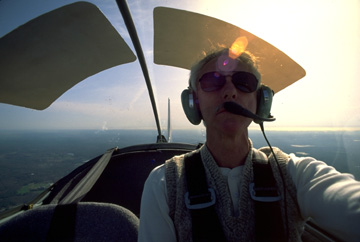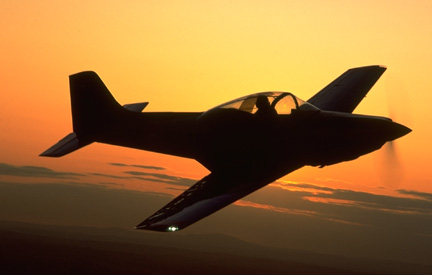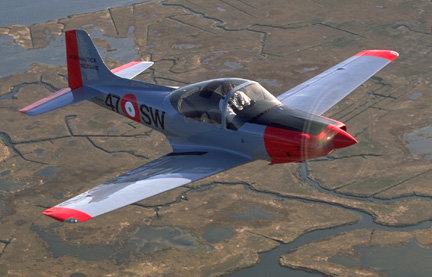Building a Falco,
Part V
![]()
Building a Falco,
|
|

The author flying his 'six-years-in-the-making sweetie'.
The FAA's odd decision to decertify my engine also means that I needn't honor possible future Lycoming AD notes either. Certainly I'll obey the ones that obviously could have an effect on the Falco's safety, but it'll be my option to disregard those sweeping directives that affect enormous numbers of engines for no real purpose other than to free a manufacturer of liability for a rare but potential problem.
Some feel that there should be uniform FAA standards to determine such things as exactly what constitutes an uncertificated powerplant or exactly how and where a homebuilt should be placarded--decisions that currently are up to individual FAA offices. The Experimental Aircraft Association wisely disagrees, even though the occasional FAA examiner is thus free to make decisions that show little sense, such a deciding that a simple three-inch-long aluminum inlet casting threw my brand-new Lycoming into the same suspicious pile as Rotaxes, belt-drive Corvair engines and tweaked Ford Pinto fours.
For if there were fixed national standards, they would almost certainly be based on the most conservative interpretations currently in use--the interpretation of a by-the-book East Coast FAA examiner who rarely sees a sophisticated homebuilt and who spends most of his time checking compliance of commuter-airline stockrooms and lavatory modifications in Gulfstream IIIs rather than the regs as read by a wise old head in homebuilt-crazy California.
Another bonus of homebuilt ownership turned out to be the repair process necessitated by the Falco's Boston belly slide. Not counting the $5,500 expense of a new constant-speed propeller, the entire airframe-repair project cost less than $1,200. Had my airplane been a Beech rather than a Frati, that amount wouldn't even have paid for hangar space in the shop to which the Falco was hauled after its unfortunate landing.

It was in fact a large Beechcraft maintenance facility, and perhaps because the staff thought the Falco cute, they didn't even bother to charge me rent during the nearly two months the airplane spent nestled under a King Air's wing. Meanwhile, they jacked the airplane up, freed the frozen jackscrew, got the gear working again, demonstrated its adequacy to the local FAA investigation team, removed and replaced the damaged propeller, checked the crankshaft runout with a dial indicator, and gave me the damaged flaps to take home and repair.
"I suppose we could figure out how to fix 'em for you, and we could replace the belly skin, but you know a lot more about wood than I do," the mechanic said. "Take 'em home, and if you want, I'll put them back on for you when they're fixed." No need, for I brought them back to Boston in a friend's 182, mounted them myself and deemed the airplane airworthy again. (I didn't yet suspect that my temporary airworthiness certificate was void, since the local FAA office had declared themselves satisfied and their investigation of the incident closed). Given the FARs that regulate production airplanes, to say nothing of the legal liabilities that hang over the heads of those who market and maintain such airplanes, none of this would ever have happened had my single been spelled "Bonanza".
Despite his work--and his $1,000 bill--the Beech technician left the airplane's log-books unsullied, doubtless because of his desire to be free of liability for an aircraft type he'd never seen before and almost certainly never would again. I've since properly recorded the incident, but perhaps I could have cheated and kept my pen dry. Of such circumstances are battered old warriors with "NDH [no damage history] created, I suppose.
Some might argue that I was taking a considerable risk flying a still partially damaged airplane home, for the Falco's belly needed reskinning where a hole the size of a saucer had been scraped through the plywood skin, and several fiberglass speed fairings were nicked or damaged. But those big labels EXPERIMENTAL on the Falco's wingwalks give me considerable leeway. (For example, despite published specs, our homebuilts have no specified gross-weight or CG limits. You "experiment" by loading fore or aft until you run out of necessary elevator and/or stability, and you add poundage until you run out of climb. If your airplane proves capable of operating at twice the published gross--due to the superiority of your workmanship, let's assume--be happy. Go fly.)
On that day, the experiment I chose to conduct was determining whether a Falco would cruise with a small hole in its belly, all gear doors removed, and the landing gear down and locked (after some careful test circuits in the airport pattern, of course). In fact, I suppose I could have logged the whole gear-up adventure as an experiment: Full-Scale, Flight-Test, Real-Time Determination of Mounting Locations for Belly Skidplate and Flap-Tip Casters to Enable Wheels-Retracted Landings.
I'd never intended for my little six-years-in-the-making sweetie to stub its toes as a demonstration of the advantages of owning a homebuilt, but that's how it worked out. In fact, I'd never intended to operate the Falco as a personal airplane in the first place, having built it as "a project" rather than as a vehicle. My purpose had been to fill spare time with an interesting woodworking affair, then sell the completed Falco and...oh, maybe restore an XK-120, install a satellite dish or learn to speak Japanese. (Activities that are guaranteed to keep you monogamous, sober and away from golf courses.)
Having flown in a few homebuilts, I'd always thought them incomplete; informal to the point of crudity. Like the kit cars enthroned on display turntables in U.S. airline terminals--"Turn your Volkswagen into this exact, 80-hp replica of a Ferrari F40, complete with AMFM radio and actual Michelin tires!"--homebuilt airplanes seemed perpetually unfinished. Duct tape was often the fastener of choice, gaps yawned here and there where interior panels disagreed, instrument panels displayed more empty places than an Olympic hockey player's smile, interior furnishings tended toward mobile-home-dinette quality. (Not that Cessna Royalite would ever make its way into Architectural Digest, at least it seems designed for its purpose.)
But the Falco is representative of the small but steadily prospering group of truly high-quality kitplanes, the Lancair and Glasair being other obvious candidates. And it turned out to be a far more complete and practical machine that I'd ever expected. "Amazing," my multi-engine-rated wife said during her first ride in the Falco. "This is a Real Airplane. All the lights light, the switches switch, the handles do what they're supposed to. What impresses me most about it is the ordinariness of the experience: it's like flying in any production airplane."
So I kept the Falco, disappointing my twelve-year-old daughter, who had been in favor of a straight-across swap for a fly-yellow Lotus Esprit Turbo. But the airplane didn't disappoint me. In fact, the more I realized its advantages, the more I wondered why so many pilots fly stodgy, expensive, ugly, undistinguished production airplanes.
What's so neat about a sophisticated homebuilt? Performance, for one thing. Without entering into mine's-bigger-than-yours arguments with builders of more modern composite homebuilts that achieve enormous speeds partly by virtue of seriously compromised cabins and what I smugly think of as extreme ugliness, it seems possible that the 180-hp Falco will cruise at just over 180 knots once a full set of landing-gear doors and other speed enhancements are in place and a slick paint job is applied over the cobby primer. Already the airplane has walked away from one friend's Debonair and another's Mooney 201, and it's probably the fastest nonturbo single at its large, busy home airport. (The tower, reporting the Falco as inbound traffic to a departing Skylane recently, said "And watch out for him--he's a speedy little devil.")
Of course, performance is a double-edged razor. The bland Piper or Cessna will go out to its way to protect a thoughtless pilot, while an aerobatic, light-handling, high-wing-loading, less stable, more spinnable high-performance homebuilt simply offers more ways to get into trouble. It's hard to ignore the fact that ten percent of the kit-built Falco fleet has been lost to fatal accidents (one apparently the result of bungled aerobatics, two more stall-spins during deadstick maneuvering after fuel exhaustion). And during 1990, three Stoddard-Hamilton Glasair IIIs--215 to 255 knot, 260-to-300 hp boomers--were totaled, moving the Avemco Insurance Company to demand that the factory set up an independent training and checkout program for Glasair III owners who want their airplanes to be Avemco-insurable.
Anybody naive enough to think this is Stoddard-Hamilton's problem need only realize that the increasing proliferation of turbocharged and high-horsepower homebuilts--not only Glasairs but large Lancairs, 300hp Questair Ventures and Lord know what else the competition might spawn--means the kitplane industry as a whole might someday have to make a rapprochement with their customers' insurers. And the judgments may go beyond flight training. One of the recently totaled Glasairs was deemed unrepairable simply because the airplane had been too ineptly constructed to make restoration viable, so someday hull insurers in the U.S. might send agents to inspect homebuilts far more rigorously than the FAA ever did.
Yet maintainability is another homebuilt virtue. My previous airplane--an elderly 250-hp Piper Comanche--had cost many thousands each year for annual inspections. Landing-gear ADs, wing-spar ADs, tank-bladder ADs, fuel-valve ADs, battery-cable ADs... the thirty-year-long list was worth from $4,000 to $6,000 each year to the enterprising maintenance shop. At that rate--roughly the cost of a new constant-speed propeller--I could afford to belly the Falco in annually. For the Falco will be mine to inspect yearly and sign off once I have obtained an FAA "repairman's certificate," which is awarded automatically by mail upon submission of a properly filled-out application.
The availability of parts with which to repair your high-performance homebuilt is generally total and immediate--Federal Express or UPS next-day air, hand-packed and addressed by Brenda or Billy-Bob or someone else with whom you've had a long-term telephone relationship while building the airplane. In fact, the day after my Falco's gear-up landing, Sequoia Aircraft's Alfred Scott was on the phone with offers of parts, advice and assistance, which I certainly wouldn't expect the CEOs--or even the service managers--of production lightplane companies to do. And my airplane's replacement propeller was volunteered by a fellow Falco builder who didn't yet need his, this sparing me the twelve-week wait specified by Hartzell. (Such cooperation is typical of the clubby nature of high-performance homebuilding in the U.S.).
You want Comanche parts? Good luck. There may be some flap tracks in a warehouse in Nebraska... and maybe the Comanche Owners Club can help... and maybe you'll just have to wait until 49 other Comanche owners need that same bracket and some supplier can afford to jig up for a run of fifty.
Perhaps I should have pocketed a repairman's certificate even to perform my own gear-up landing repairs. But since the incident occurred during the Falco's initial test-flying hours, my rationalization was that I was a homebuilder performing normal modifications and enhancements to the airplane necessitated by a test program. In fact, the way the EAA interprets the rules, I can work on my airplane all I want, whenever I want, so long as it's legally airworthy. The only benefit of the repairman's certificate is that it allows me to sign off the annual, on the theory that nobody else knows the airplane as well as I do.

Camera-plane pilot smiling above was singer
Livingston Taylor, brother of the more famous James.
This permission even extends to routine inspection and maintenance of the Falco's Lycoming engine and Hartzell propeller, though this has become a subject of recent discussion in EAA-FAA circles. One petition requiring A&P inspection--or at least sign-of--of certificated engines and props on homebuilts was put forth (and accepted routinely by the FAA as a potential proposal for rule making) by a non-pilot Massachusetts Institute of Technology student as part of his master's thesis. Another was proposed by a conservative ex-FAA airworthiness-branch employee who'd spent much of his Government career agitating with no success for such a rule change. When he early-retired recently, he took up the cudgel as a private citizen.
Both proposals elicited firestorms of negative comment from not only homebuilders but FAA folk, pointing out that nothing in experimental-aircraft accident history points to homebuilder maintenance of type-certificated engines and props as a cause of crashes. The petitions will almost certainly wither on the vine of proposed rule making.

Yet another potential homebuilt benefit is the quality of the airplane's equipment and furnishings, for few upscale homebuilders built "to a price", as manufacturers must. So for my seats and sidepanels, I was able to choose the best nubby tweed available at a local upholstery shop. My floor carpeting is made for Mercedes-Benz restoration shops, and the glareshield and turtledeck are covered in Connolly leather. And most important, the over-the-counter components supplied by Sequoia Aircraft are of the highest quality, from Potter & Brumfeld circuit breakers and expensive Teflon-covered electrical wire to stainless-steel control cables and external fasteners throughout.
Frankly, it certainly changed this 25-year production-aircraft pilot's outmoded view of homebuilts. The market has in many senses outgrown the nomenclature, and it's hard to tell which is a more negative term: "experimental", with its hint of chemistry-set casualness... "amateur-built", suggesting a script for a TV how-to show... or "homebuilt", which instills adequate confidence in guests when the subject is a patio but does little for neophyte Falco passengers.
On January 24, 1992, the FAA finally said farewell to me, with the award of an experimental airworthiness certificate for the Falco. Even its many stipulations--no for-hire flight, pilot must warn each passenger of the experimental nature of the aircraft, etc, etc--reveal the freedom under which American pilots operate. To fly the Falco IFR or at night, for example, I need no further flight testing or approval, as long as the airplane has the requisite lights, instruments and radios.
And the seemingly most restrictive of the certificate's covenants--that an experimental aircraft must never be operated over congested areas "except when taking off or landing"--is vastly softened by a loophole pointed out to me by an experienced EAA spokesman. "You know, there's always an airport somewhere," he mused, "that you can claim to have been approaching or departing from if they claim you were flying over a congested area."